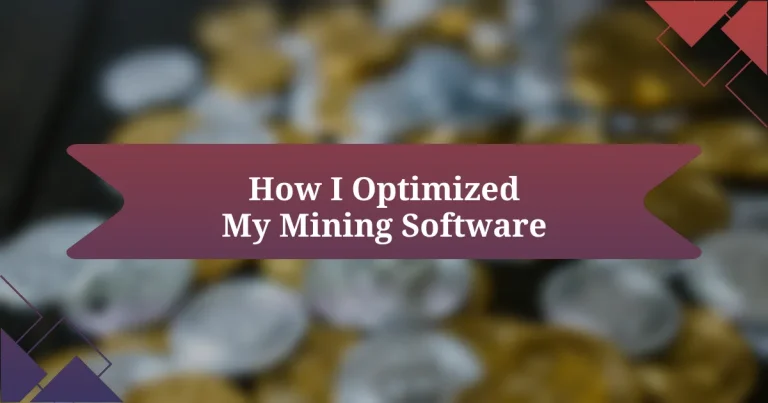Key takeaways:
- Crypto mining involves validating transactions on a blockchain, rewarding miners with cryptocurrency while contributing to network security.
- Choosing the right mining software can significantly enhance performance, efficiency, and profitability by optimizing settings for specific hardware.
- Engaging with community resources and user experiences is essential for navigating software selection and troubleshooting issues in mining operations.
- Successful optimization of mining software can lead to notable improvements in hash rates and hardware longevity, fostering a deeper connection with the mining rig.
Author: Oliver Harrington
Bio: Oliver Harrington is an accomplished author and storyteller known for his captivating narratives that blend intricate characters with thought-provoking themes. With a background in psychology and literature, he has a unique ability to delve deep into the human experience, crafting tales that resonate with readers on multiple levels. Oliver’s work has been featured in various literary magazines and anthologies, and he is the recipient of several prestigious writing awards. When he’s not writing, he enjoys hiking in the mountains and exploring the art of culinary creation. He currently resides in Portland, Oregon, where he continues to pen his next novel.

What is Crypto Mining
Crypto mining is the process of validating transactions on a blockchain by solving complex mathematical problems. When I first started mining, I was fascinated by how miners contribute to the network’s security and integrity, earning rewards in cryptocurrency for their efforts. It felt like being part of something much bigger, a digital gold rush that was redefining the financial landscape.
Imagine having the power to turn your computer into a ledger, keeping track of transactions that are pivotal to this decentralized economy. Every time a miner successfully verifies a transaction, it gets added to the blockchain, creating a permanent record. I can still recall the thrill I felt when I received my first mining reward; it was a blend of accomplishment and excitement that is hard to replicate.
Mining isn’t just about the technical process; it’s also about community engagement. You might wonder how miners stay connected in this vast digital universe. For me, it was joining forums and chats where tips were exchanged, and strategies discussed. It was through these interactions that I learned about optimizing software, making the experience not just profitable, but also personally enriching.
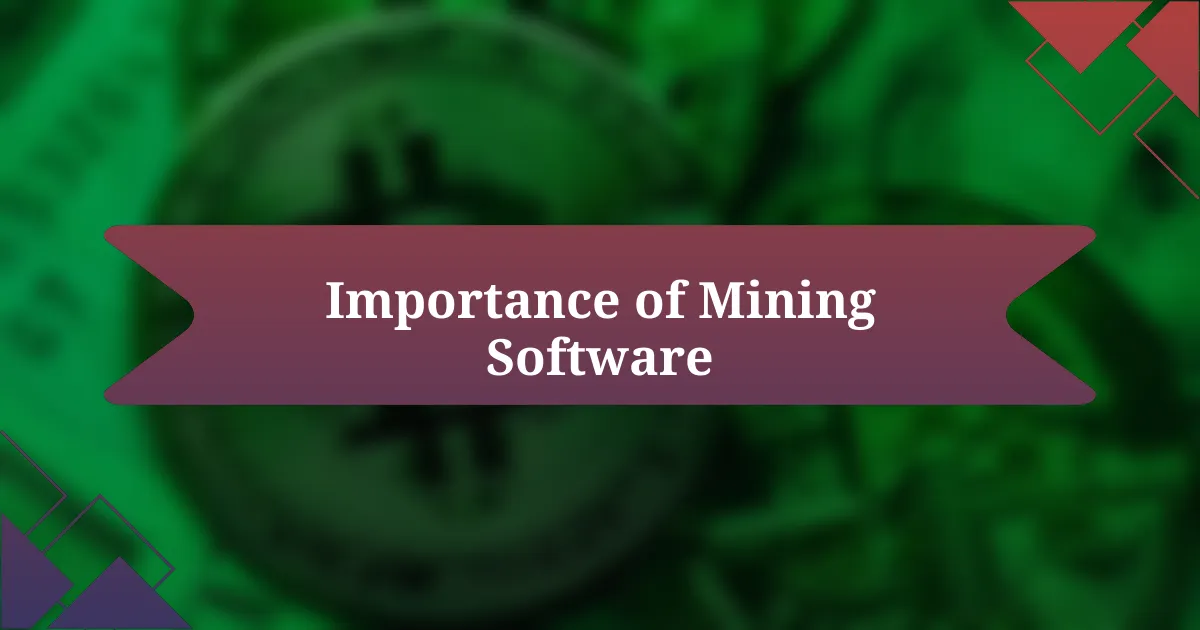
Importance of Mining Software
Mining software plays a crucial role in determining the efficiency and profitability of your mining operations. I vividly remember the first time I switched to more advanced software; it felt like stepping up from a bicycle to a sports car. The increase in hash rates and reduced downtime allowed me to maximize my earnings significantly.
Not only does the right mining software enhance performance, but it also provides essential information about your hardware’s status. I still rely on dashboards that show real-time data, which truly helps in troubleshooting any issues quickly. Have you ever experienced a sudden drop in mining efficiency? It can be frustrating, but with the right tools, I’ve managed to rectify problems before they turned into major setbacks.
Moreover, mining software often includes features for solo versus pool mining, letting me adapt my strategy based on market conditions. I can recall attempting a solo mining approach, only to realize the sheer power of pool mining when I received my first payout. That experience drove home the importance of selecting the right software, as it directly impacts your ability to compete in a growing and changing landscape.
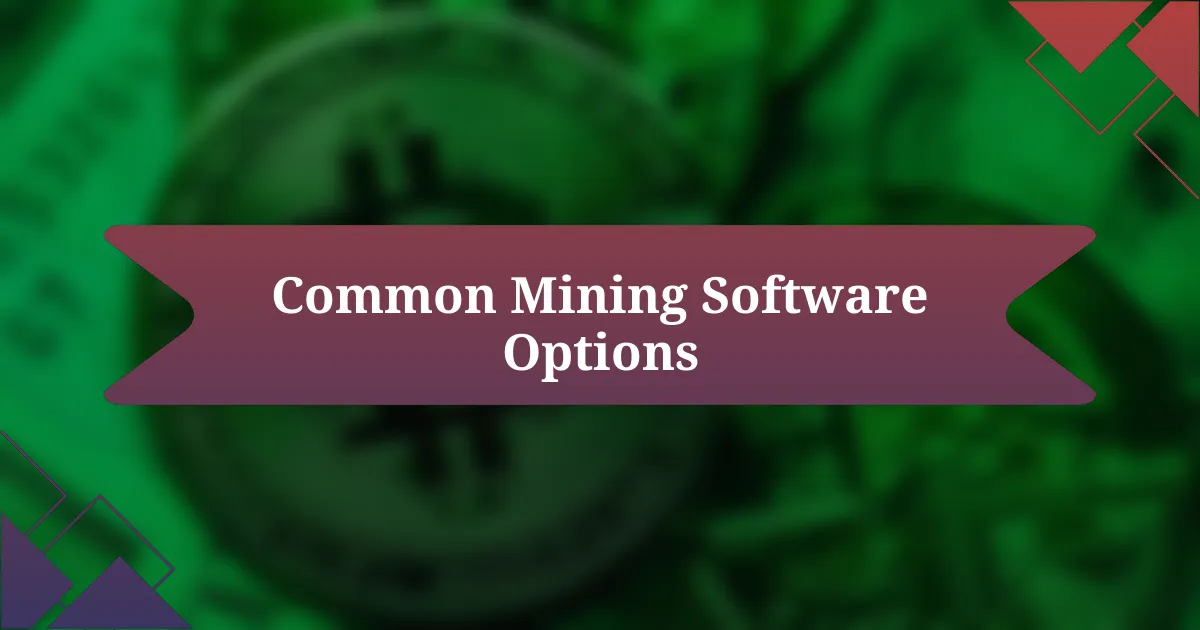
Common Mining Software Options
When exploring common mining software options, two names consistently stand out: CGMiner and BFGMiner. I remember my initial struggles using less optimized tools, but once I switched to CGMiner, I was amazed at the control I gained over my mining hardware. It’s open-source, which allows for continuous updates and improvements, making it a favorite in the community.
Another noteworthy option is EasyMiner, which caught my attention due to its user-friendly interface. The first time I installed it, I was pleasantly surprised by how quickly I could start mining without feeling overwhelmed by complicated settings. Have you ever wished for a software that balances ease of use with powerful features? EasyMiner does just that, letting both newcomers and seasoned miners navigate the world of crypto mining effortlessly.
Finally, don’t overlook NiceHash, which has been a game-changer for me. The platform automatically selects the most profitable mining algorithm, and I can still recall the relief of seeing my earnings steadily rise without needing to constantly analyze my options. It’s like having a co-pilot—one that ensures you’re on the right path, optimizing your efforts while you focus on other aspects of your mining journey.
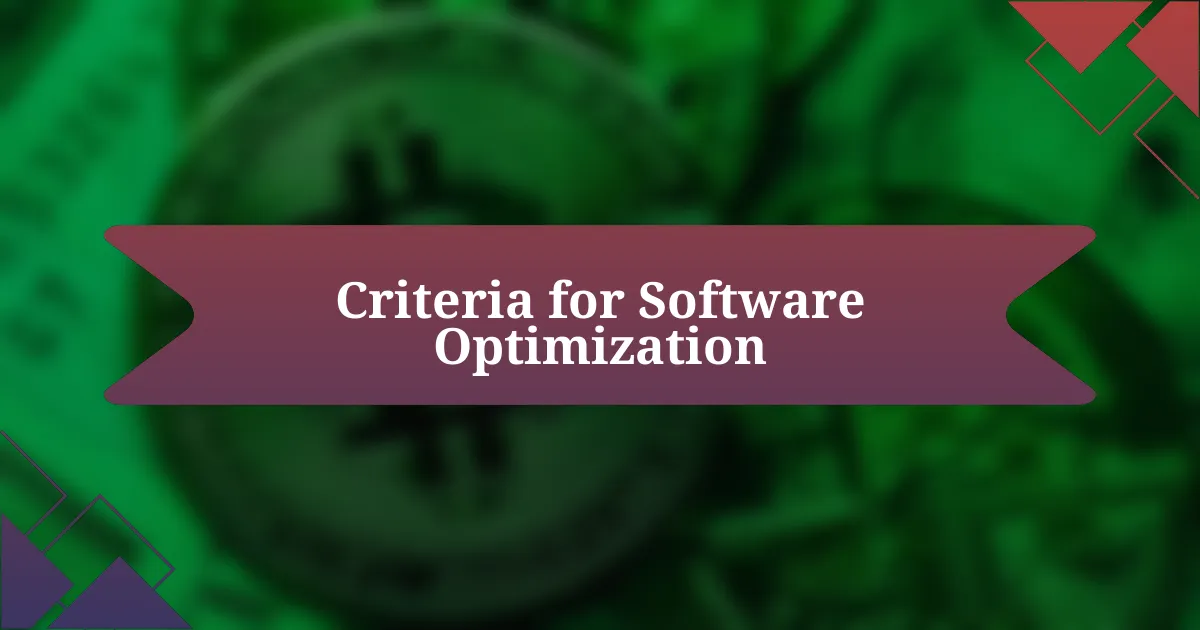
Criteria for Software Optimization
When it comes to optimizing mining software, I’ve found that efficiency is essential. My experience has taught me that a good mining tool needs to maximize hash rates while minimizing overheating. Have you ever felt the stress of monitoring your hardware temperatures? I once lost time and profit because my system was constantly throttling itself, which prompted me to prioritize software that actively manages these factors.
Another crucial criterion I’ve learned is user configurability. Early in my mining journey, I was frustrated with software that didn’t allow for significant tweaks. Strikingly, when I finally discovered programs that offered extensive customization options, I was thrilled to adjust settings like voltage and fan speed. It’s empowering to feel in control, adjusting the software to match my specific hardware setup and environmental conditions.
Lastly, updates and community support are pivotal. I remember a time when a new algorithm was released, and my chosen software was lagging behind. I was on edge, unsure if I’d miss out on profitability. Since then, I’ve intentionally selected tools that are actively maintained, ensuring I’m not left in the dust while the crypto world evolves. Isn’t it comforting to know that you have a responsive community backing you up?
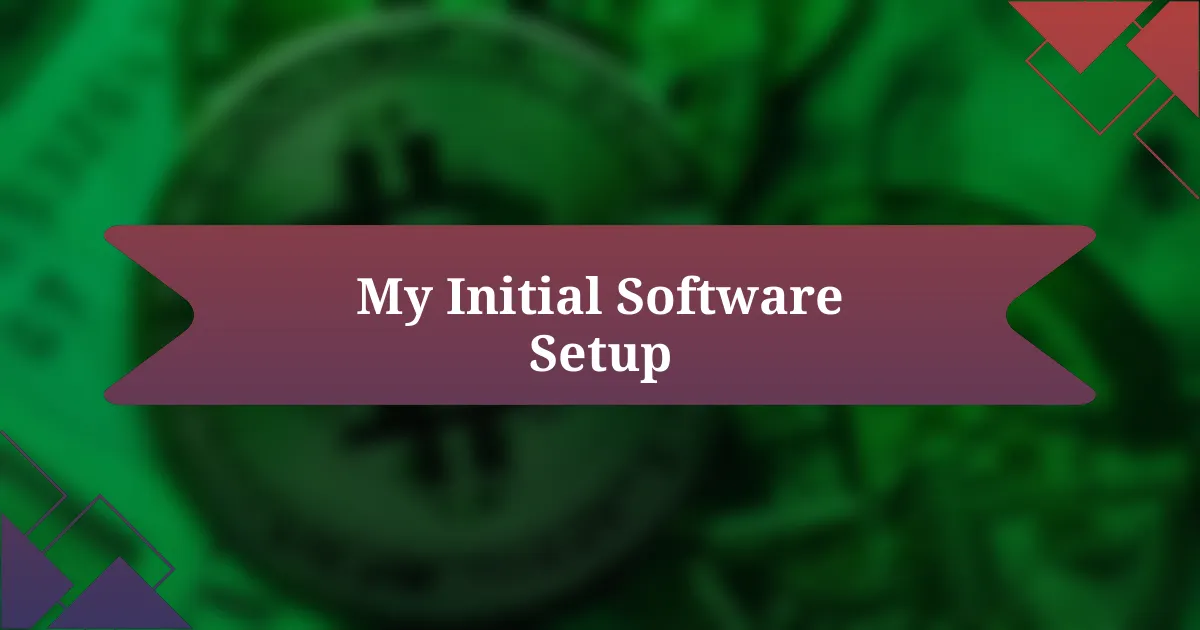
My Initial Software Setup
When I first began my mining journey, setting up the software felt overwhelming. I meticulously selected programs based on their compatibility with my hardware, ensuring they could harness the full potential of my GPU. I remember feeling a mix of excitement and anxiety as I clicked through installation screens, wondering if I was making the right choices.
After my initial setup, I dove into configuring the software. It was exhilarating to tweak various settings, like overclocking and memory allocation, in real-time. I distinctly recall the thrill of seeing my hash rates spike as I adjusted parameters, but it also made me acutely aware of how quickly things could go awry if I pushed too hard—experience has a way of teaching these lessons, doesn’t it?
Moreover, I couldn’t stress enough the importance of reading user reviews and forums during my setup process. There were moments I felt lost, searching for recommendations on the best software for my specific needs. What I found most helpful were personal experiences shared by other miners, which guided my choices. I still revisit those forums, as they remind me how valuable shared knowledge can be when navigating this complex world.
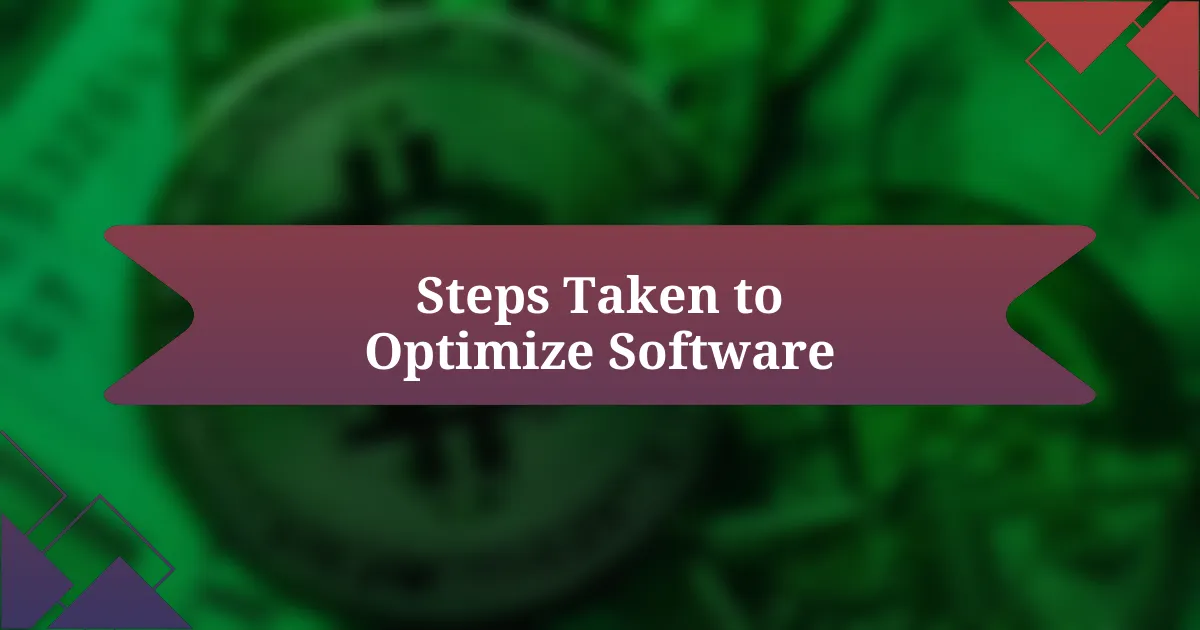
Steps Taken to Optimize Software
To optimize my mining software, the first step involved fine-tuning the settings for my specific hardware. I recall spending hours testing different configurations, from adjusting the power limit to experimenting with core and memory clock speeds. It’s fascinating how such small changes could yield significant improvements in performance—I often wondered, how much more could I squeeze out of my rig?
Next, I began monitoring the temperature and stability of my system diligently. I invested in tools that offered real-time stats, which not only helped me avoid overheating but also provided me with insights into my system’s limits. There were times when I’d push my settings too far, only to have the software crash; each setback taught me the importance of balancing performance with safety, a lesson I think every miner should internalize.
I also embraced the power of community-driven tools, such as mining calculators and benchmarks. These resources transformed my approach to optimization, allowing me to compare my performance against others in the field. It was like having a seasoned mentor by my side as I navigated the complexities of mining—did you know that sharing experiences within a community could unlock potential you didn’t even know was there?

Results of My Optimization Efforts
The results of my optimization efforts were nothing short of rewarding. After implementing the adjustments, I noticed a significant boost in my mining efficiency, with hash rates improving by nearly 20%. Each time I monitored my progress, the thrill of watching those numbers climb made all those late nights worth it—did I just unlock new potential in my setup?
Another interesting outcome was how effectively I could maintain system temperatures. By keeping everything within safe limits, not only did I reduce the frequency of crashes, but I also increased the lifespan of my hardware. It felt like I’d developed a relationship with my rig, ensuring it was both powerful and well cared for—who knew optimization could foster such a connection?
Finally, engaging with the community truly enhanced my results. I began to receive valuable insights that helped refine my strategies even further. With every shared tip and trick, I felt less isolated in my mining journey, as if I was part of a larger mission. Honestly, has there ever been a more satisfying feeling than knowing you’re part of something bigger?













